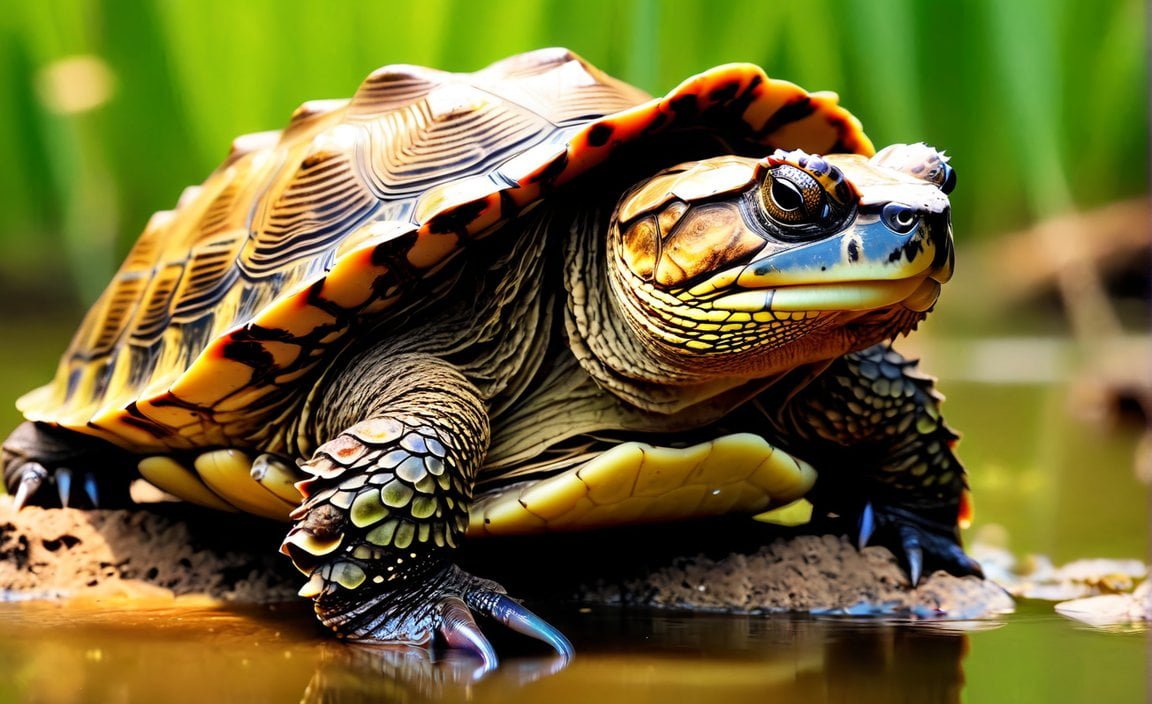Discover the Top 10 Fascinating Facts About Snapping Turtles and dive into the captivating world of these ancient creatures. As a seasoned wildlife enthusiast and experienced nature writer, I have delved deep into the realm of snapping turtles, uncovering their intriguing secrets. With my expertise in environmental science and years spent studying aquatic reptiles, I have compiled a list of the most captivating facts that will both ignite your curiosity and promote environmental awareness. Through a unique blend of scientific accuracy and captivating storytelling, join me on this journey to unravel the mysteries of snapping turtles.

Key Takeaways:
- Snapping turtles cannot retreat into their shells.
- The sex of snapping turtles is determined by temperature.
- Snapping turtles take a long time to grow up.
- They spend most of their time underwater.
- Snapping turtles can be hunted.
- Alligator snapping turtles can live up to 150 years.
- They have a unique defense mechanism.
- Snapping turtles have powerful jaws and sharp beaks.
- Snapping turtles do not lay their eggs in sand or soil.
- There are two types of snapping turtles: common snapping turtles and alligator snapping turtles.
10 Interesting Facts About Snapping Turtles
Snapping turtles are fascinating creatures that have captured the attention of wildlife enthusiasts and researchers alike. These ancient reptiles possess several unique traits and behaviors that set them apart from other species. In this article, we will dive deep into the world of snapping turtles and uncover the ten most captivating facts about them.
1. Snapping Turtles Cannot Retreat into Their Shells
Unlike many other turtle species, snapping turtles are unable to retract their heads and limbs into their shells for protection. Instead, they rely on their tough, leathery skin and powerful jaws to defend themselves against potential threats. Their unique inability to seek refuge in their shells makes them formidable and interesting creatures to observe.
2. The Sex of Snapping Turtles is Determined by Temperature
In a fascinating display of nature’s ingenuity, the sex of snapping turtles is determined by the temperature at which their eggs are incubated. Higher temperatures tend to produce female turtles, while lower temperatures result in males. This remarkable adaptation ensures a balanced population and highlights the intricate relationship between turtles and their environment.
3. Snapping Turtles Take a Long Time to Grow Up
Snapping turtles have a relatively slow growth rate compared to other turtle species. It can take them up to 20 years to reach sexual maturity. This extended period of development emphasizes their longevity and the importance of protecting their habitats to ensure their survival in the wild.
4. They Spend Most of Their Time Underwater
Snapping turtles are highly adapted to an aquatic lifestyle. They spend the majority of their time submerged in water, emerging periodically to breathe. Their ability to stay underwater for extended periods makes them excellent swimmers and allows them to capture prey with precision.
5. Snapping Turtles Can Be Hunted
Due to their size, behavior, and culinary value, snapping turtles have been hunted by humans for centuries. In some regions, they are considered a delicacy and are sought after for their flavorful meat. However, it’s important to regulate harvesting practices to ensure sustainable populations and protect these magnificent creatures.
6. Alligator Snapping Turtles Can Live Up to 150 Years
The alligator snapping turtle, a subspecies of snapping turtle, holds the record for one of the longest lifespans among turtles. With a lifespan that can exceed 150 years, these ancient creatures have witnessed countless changes in their environment and serve as a testament to the resilience of nature.
7. They Have a Unique Defense Mechanism
Snapping turtles possess a remarkable defense mechanism that involves their powerful jaws and sharp beaks. When threatened, they can lunge forward with lightning speed, capturing prey or deterring potential predators with a forceful bite. Their ability to defend themselves showcases their fierce nature and survival instincts.
8. Snapping Turtles Do Not Lay Their Eggs in Sand or Soil
Unlike many other reptiles, snapping turtles do not lay their eggs in conventional nesting sites such as sandy beaches or soil. Instead, females search for areas with loose, damp soil or vegetation to dig their nests. This behavior ensures that their eggs are protected and concealed from predators until they are ready to hatch.
9. Snapping Turtles Have a Unique Adaptation That Allows Them to Breathe Underwater
One of the most remarkable adaptations of snapping turtles is their ability to extract oxygen from the water they inhabit. By employing specialized structures in their throats called “cloacal bursae,” these turtles can extract oxygen directly from the water, allowing them to remain submerged for extended periods without needing to surface for air.
10. There Are Two Types of Snapping Turtles: Common Snapping Turtles and Alligator Snapping Turtles
Snapping turtles can be classified into two main types: common snapping turtles (Chelydra serpentina) and alligator snapping turtles (Macrochelys temminckii). While both share similar characteristics, there are distinct differences between the two. Alligator snapping turtles, for example, are known for their massive size, with some individuals weighing over 200 pounds. On the other hand, common snapping turtles usually have a more modest size, making them a bit smaller in comparison.
In conclusion, snapping turtles are captivating creatures that possess a unique set of attributes and adaptations. Their inability to retreat into their shells, the temperature-dependent determination of their offspring’s sex, and their remarkable defense mechanisms are just a few examples of the myriad of intriguing facts that make them a subject of fascination. By understanding and appreciating these incredible reptiles, we can contribute to their protection and preservation for generations to come.
Here are some interesting links for you to explore:
- 10 fun facts about hawksbill sea turtles: Discover some fascinating information about these amazing sea creatures.
- 10 human foods dogs can eat: Find out which human foods are safe and healthy for your furry friends.
- 10 human foods that are good for dogs: Learn about nutritious human foods that can benefit your four-legged companions.
- 10 interesting facts about alligator snapping turtles: Dive into the world of alligator snapping turtles with these intriguing facts.
- 10 interesting facts about being a veterinarian: Gain insight into the fascinating life of a veterinarian.
- 10 interesting facts about falcons: Uncover captivating facts about these majestic birds of prey.
- 10 interesting facts about hawksbill sea turtles: Delve into the wonders of hawksbill sea turtles with these intriguing facts.
- 10 interesting facts about hawksbill turtles: Discover unique and fascinating facts about hawksbill turtles.
- 10 interesting facts about the hawksbill sea turtle: Learn interesting details about the hawksbill sea turtle, one of nature’s remarkable creatures.
Feel free to click on any of these links to explore more about these fascinating topics!
Their Remarkable Ability to Adapt to Different Habitats
Turtles, the ancient reptiles that have roamed the Earth for millions of years, possess a remarkable ability to adapt to various environments. As they have evolved over time, different species of turtles have developed unique adaptations that allow them to thrive in diverse habitats. Let’s dive into the intriguing world of snapping turtles and explore their exceptional adaptability.
1. A Shell Suited for Survival
One of the most iconic characteristics of turtles is their shell, which acts as a protective shield. However, snapping turtles take it a step further with their ability to adapt the shape and structure of their shell to suit their habitat. Whether it’s a swampy marsh or a freshwater pond, snapping turtles can adjust their shell to blend in perfectly, ensuring their survival in different environments.
2. Master of Aquatic Life
While snapping turtles are primarily aquatic creatures, they’re not limited to one type of water habitat. These adaptable reptiles can thrive in various aquatic settings, including lakes, rivers, ponds, and swamps. Their remarkable ability to navigate and survive in different aquatic ecosystems showcases their prowess as masters of aquatic life.
3. Embracing the Muddy Bottom
When it comes to snapping turtles, muddy bottoms are their preferred habitat. These creatures are well-suited to habitats with muddy or soft substrate, providing them with plenty of cover and the perfect environment to dig burrows for hibernation. The world beneath the murky swamp is where snapping turtles feel right at home.
4. Climbing Out of the Water
Snapping turtles not only dwell in water but also require access to land. Their preferred habitats offer ample places to climb out of the water, such as fallen logs or muddy banks. These areas provide the ideal basking spots for snapping turtles to soak up the warmth of the sun and manage their body temperature effectively.
5. An Opportunistic Palate
Snapping turtles are known for their adaptability when it comes to feeding. They display a diverse range of feeding behaviors and are considered opportunistic eaters. These adaptable reptiles consume a varied diet, including aquatic plants, small fish, insects, amphibians, and even carrion. Their adaptability in food choices ensures that they can find sustenance in different habitats.
6. Survival of the Aquatic
Snapping turtles possess a unique adaptation that allows them to breathe underwater. Known as cloacal respiration, these reptiles can extract oxygen from the water by absorbing it through specialized tissue in their cloaca. This remarkable adaptation enables them to stay submerged for extended periods, enhancing their chances of survival in their watery homes.
7. A Life of Patience
Snapping turtles exhibit a slow growth rate, taking up to 20 years to reach sexual maturity. This extended period of growth may seem unusual, but it actually contributes to their survival and adaptability. By taking the time to mature fully, snapping turtles can ensure strong and resilient offspring, securing the continuation of their species in various habitats.
8. Relying on Survival Skills
Snapping turtles are highly adaptable in their defense mechanisms. They possess powerful jaws and sharp beaks, allowing them to defend themselves against predators and capture prey effectively. This unique adaptation plays a vital role in their survival, enabling them to navigate the challenges present in different habitats and emerge as skilled survivors.
9. Adapting in the Face of Change
In today’s rapidly-changing world, animals’ ability to adapt to new conditions is crucial for their survival. Snapping turtles, with their incredible adaptability, hold an advantage in the face of climate change. Their ability to respond and adjust to alterations in their habitats increases their chances of enduring the effects of environmental transformations.
10. A Testament to Resilience
The remarkable ability of snapping turtles to adapt to different habitats is a testament to their resilience as a species. From the muddy bottoms to the sunlit banks, and everything in between, snapping turtles have proved time and again that they can navigate the challenges presented by various environments. Their adaptability sustains them and ensures their continued presence across different ecosystems.
Key Takeaways:
- Snapping turtles possess an exceptional ability to adapt to different habitats, showcasing their resilience as a species.
- Their shells can adjust to suit the specific environment they inhabit, providing them with optimum protection.
- Snapping turtles thrive in a range of aquatic habitats, including lakes, rivers, ponds, and swamps.
- Muddy bottoms serve as the preferred habitat for these reptiles, offering the ideal conditions for digging burrows and hibernation.
- Snapping turtles require access to land and can often be found basking on fallen logs or muddy banks.
- These adaptable reptiles are opportunistic eaters, consuming a diverse range of foods to meet their nutritional needs.
- Snapping turtles possess a unique adaptation, allowing them to extract oxygen from water through cloacal respiration.
- Their slow growth rate and extended maturity contribute to their survival, ensuring strong offspring in various habitats.
- Snapping turtles rely on their powerful jaws and sharp beaks for defense and prey capture.
- Their adaptability positions them well in the face of climate change, enabling them to respond and adjust to alterations in their habitats.
Source:
– “Turtle – Adaptations, Habitats, Lifespan” | Britannica
– “Snapping Turtle” | Animals Network
Their Long Lifespan and Slow Growth Rate
Snapping turtles, fascinating creatures that they are, have a long lifespan and a surprisingly slow growth rate. These characteristics contribute to their resilience and remarkable survival strategies. Let’s delve into these intriguing aspects of snapping turtles’ lives.
1. A Life Span of Remarkable Duration
Snapping turtles are known for their longevity. With a maximum lifespan of about 50-70 years in the wild, these ancient reptiles have witnessed the passage of time and have adapted to environmental changes over the years. Their ability to thrive for decades highlights their resilience and remarkable traits.
2. Patient Growth
While some animals grow rapidly, snapping turtles possess a unique quality – a slow growth rate. It may take up to 20 years for them to reach sexual maturity, showcasing their patient and deliberate journey towards adulthood. This slow growth rate ensures that they are well-equipped to navigate their surroundings before engaging in reproduction, allowing for a more successful and sustainable population.
3. A Marvel of Adaptation
The long lifespan and slow growth rate of snapping turtles contribute to their incredible adaptability. They have managed to evolve and thrive in various aquatic habitats, including lakes, ponds, canals, and rivers. This adaptability enables them to adjust to different conditions, ensuring their survival even in the face of environmental changes.
4. Resilience in Challenging Environments
Snapping turtles are masters of survival. Thanks to their long lifespan and slow growth rate, they have developed mechanisms to withstand the harsh conditions of their habitats. These resilient creatures can adapt to brackish waters, demonstrating their ability to thrive in diverse environments. Their remarkable adaptability showcases their evolutionary prowess.
5. Guardians of Ancient Wisdom
With their long lifespan and slow growth rate, snapping turtles have become guardians of ancient wisdom. They have witnessed the environmental changes occurring over decades, providing researchers and conservationists with valuable insights into the impact of human activities on their habitats. By studying these resilient creatures, scientists can gain a deeper understanding of the effects of climate change and develop effective strategies for conservation.
Key Takeaways:
- Snapping turtles boast a long lifespan of about 50-70 years in the wild, enabling them to witness and adapt to environmental changes.
- Their slow growth rate of up to 20 years to reach sexual maturity ensures a deliberate and successful journey into adulthood.
- This patient growth contributes to their resilience and ability to thrive in various aquatic habitats.
- Snapping turtles’ adaptability allows them to adjust to brackish waters, showcasing their remarkable survival skills.
- Their long lifespan and slow growth rate provide valuable insights into the impact of human activities and help identify effective conservation strategies.
Citations:
- 10 Incredible Snapping Turtle Facts – AZ Animals
- What Are Some Interesting Facts About Snapping Turtles – Joy of Animals
Their Essential Role in the Ecosystem and Conservation Efforts
Key Takeaways:
- Turtles play a vital role in maintaining the balance of ecosystems by controlling populations of other animals, dispersing seeds, and contributing to plant growth.
- Conservation efforts for turtles are crucial for the survival of other marine species and the overall health of the ocean ecosystem.
- Snapping turtles, as apex predators, have significant effects on ecosystem dynamics and can directly influence amphibian communities and prey populations.
- The decline of turtle populations globally has led to a diminished ecological role, impacting the ability to fulfill their functions within ecosystems.
- Conservation is essential for maintaining biodiversity, ecosystem functioning, and human well-being.
Turtles are not just fascinating creatures; they also play a crucial role in maintaining the health and balance of ecosystems. Their essential role in the ecosystem and conservation efforts cannot be overstated. Let’s explore the ten most captivating facts about snapping turtles and how their existence impacts the world around us.
Fact 1: Guardians of Ecosystems
Snapping turtles hold a prominent position as regulators of population dynamics in ecosystems. They help control the populations of insects, small mammals, and even other reptiles. By maintaining these populations, snapping turtles contribute to the overall health of both aquatic and terrestrial habitats.
Fact 2: Seed Dispersal and Plant Growth
Turtles indirectly contribute to plant growth through seed dispersal. As they move around, seeds attach to their bodies and are dispersed to new locations. This process enhances plant diversity and allows for the growth of new vegetation, benefiting the ecosystem as a whole.
Fact 3: Managing Seagrass Beds
Snapping turtles help maintain the balance of ecosystems by feeding on seagrass beds. By doing so, they prevent overgrowth and keep seagrass at a healthy length. This activity promotes biodiversity in the aquatic environment and contributes to the overall functioning of the ecosystem.
Fact 4: Controlling Jellyfish Population
Jellyfish populations can quickly spiral out of control, causing disruptions in marine ecosystems. Snapping turtles play a role in maintaining these populations by feeding on jellyfish, thus preventing their overpopulation. This control helps preserve the delicate balance of marine ecosystems.
Fact 5: Conservation for Ocean Health
Conservation efforts for turtles are crucial for the survival of other marine species and the overall health of the ocean ecosystem. Protecting turtles involves addressing issues such as unsustainable fishing, reducing ocean pollution, mitigating global warming, and protecting vital habitats like coral reefs, mangroves, and seagrass beds. These efforts are essential to ensure the health and sustainability of our oceans.
Fact 6: Apex Predators in Aquatic Ecosystems
Snapping turtles are apex predators in aquatic ecosystems, meaning they have a significant impact on the dynamics of these ecosystems. Their presence can directly alter the composition of amphibian communities and affect the body condition of their prey. Understanding the role of snapping turtles is crucial to maintaining the delicate balance of aquatic ecosystems.
Fact 7: Decline of Turtle Populations
Globally, turtle populations have experienced a decline, which has diminished their ecological roles within biotic communities. The loss of turtle populations has disrupted the functioning of ecosystems and their ability to fulfill important ecological functions. Protecting and conserving these creatures is vital to restore the balance and resilience of ecosystems.
Fact 8: The Importance of Conservation
Conservation is the study of preventing the loss of Earth’s biological diversity. It is crucial for maintaining the natural functioning of ecosystems and protecting biodiversity. Sustaining ecosystems is not only essential for biodiversity conservation but also for human well-being. Recognizing the value of turtles and their role in ecosystems is a fundamental aspect of effective conservation efforts.
Fact 9: Understanding the Effects of Climate Change
Studying snapping turtles can provide valuable insights into the impact of human activities, including climate change, on their habitats. By understanding how turtles respond and adapt to changing environments, scientists can develop conservation strategies to mitigate the negative effects of climate change and protect these important species.
Fact 10: Inspiring Environmental Awareness
By uncovering the intriguing facts about snapping turtles and sharing these stories, we hope to ignite curiosity and promote environmental awareness. Understanding the essential role of snapping turtles in ecosystems highlights the interconnectedness of all living organisms and emphasizes the urgency of conservation efforts.
(Sources:
1. American Oceans: Why Are Turtles Important for Ecosystems?
2. Forever Wildlife: 10 Fascinating Facts About Sea Turtles You Didn’t Know)

FAQ
Q1: Do snapping turtles lay their eggs in sand or soil like other turtles?
A1: No, snapping turtles do not lay their eggs in sand or soil. Instead, female snapping turtles seek out soft soil or loose vegetation near bodies of water to dig a nest and deposit their eggs.
Q2: What is the unique defense mechanism of snapping turtles?
A2: Snapping turtles have a unique defense mechanism where they can extend their necks and lunge forward aggressively to bite when they feel threatened. They are known for their powerful jaws and sharp beaks.
Q3: How long does it take for snapping turtles to reach maturity?
A3: Snapping turtles take a long time to grow up. It can take anywhere from 15 to 20 years for them to reach sexual maturity, and they can continue to grow and live for several more decades.
Q4: Are alligator snapping turtles the same as common snapping turtles?
A4: No, alligator snapping turtles and common snapping turtles are two different types of snapping turtles. Alligator snapping turtles are larger and have a heavier body compared to common snapping turtles. They also have distinct ridges on their shells.
Q5: Can snapping turtles breathe underwater?
A5: Yes, snapping turtles have a unique adaptation that allows them to breathe underwater. They have the ability to extract oxygen from the water through specialized structures in their throat called cloacal bursae, enabling them to stay submerged for extended periods.
- Unveiling the Enigma: Mansoureh Khojasteh Bagherzadeh’s Public Appearances & Private Life in Iran - July 18, 2025
- Unveiling the Mystery: Mansoureh Khojasteh Bagherzadeh’s Husband: A Rare Glimpse into a Private Life - July 18, 2025
- Unveiling Masoud Khamenei’s Mother: Power, Influence, and Iran’s Future - July 18, 2025
















